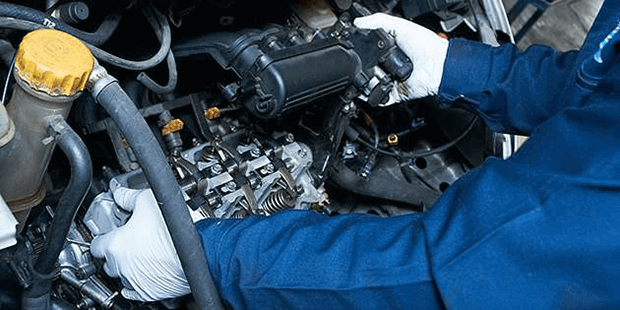DuPont is one of the leading companies in thermoplastics, elastomers, finished parts and biopolymers, combining ground breaking material science with global access. Plastics are at the heart of many of today’s technological advances, especially in the automotive industry where DuPont is collaborating to further develop lighter weight components that meet performance and environmental requirements. Below is our interview with Thomas Oury, European Director at DuPont Performance Materials:

Q: What is DuPont Performance Materials? How do you fit in with the automobile sector?
A: DuPont Performance Materials (DPM) offers lightweight alternatives to metal and rubber for planes, trains and automobiles as other sectors too. Since we developed the first polymer (Nylon) in 1935, we’ve been growing as a leader in providing an extensive mix of plastics, elastomers, renewably-sourced polymers, and high-performance parts and shapes. These are products that are found more and more in different appliances we use every day. We can even say that virtually everything in a car can be done with plastic.
Q: Who are your typical customers and what are the main challenges they are facing?
A: As a global company with a unique combination of material science, world class production innovation design and hands-on industry support, our customers are situated throughout the supply chain. To continue with the example of the car, the automotive industry constantly seeks materials that will help them reduce vehicle production time, total system costs and environmental impact. To meet these environmental and economic targets, car manufacturers and first tier suppliers collaborate with us to take advantage of our expertise in materials, design and processing technologies from the earliest stages of development until the finished vehicle rolls off the manufacturer’s assembly line. We also run trainings and provide application support such as computer-aided engineering to help designers understand the potential of our material portfolio as it still an industry in its infancy.
 Recommended: Washos Is Changing The Way People Take Care Of Their Cars
Recommended: Washos Is Changing The Way People Take Care Of Their Cars
In the near future (by 2021), new passenger cars and vans across Europe will be expected to have reduced their average CO2 emissions by 40% (in comparison to 2007 fleet). In the US it is much the same with an even lower target for 2025. Governments and consumers around the world are calling for reduced fuel consumption and CO2 emissions which means that car manufacturers need to have this in the back of their mind during design and construction.
Lightweighting remains the biggest leverage available for vehicle manufacturers in this regard. For instance, a 110kg weight reduction can decrease CO2 emissions by 10g/km driven.
DuPont offers longer-life, high-temperature, chemically resistant materials including elastomers, resins and reinforcement technologies to help manufacturers avoid having to revert back to costly, heavier metals. Plastics are inherently lighter than metals, but lightweighting requires more than direct material substitution. This means pushing innovation further to make technologies and materials to provide energy-efficient and sustainable solutions. DPM’s high-performance materials, predictive engineering and design teams work with customers to redesign.
Q: What is the role of technology for a materials company?
A: The advent of high-powered computing combined with state-of-the art materials and highly qualified design experts has certainly taken computer-aided design and simulation engineering to a new level for our value-chain partners. At DPM, we’ve developed state-of-the-art advanced computer modelling and simulation tools to anticipate the performance of parts. The old “crash it, fix it, then crash it again” trial and error testing process used to take on average four and a half years. Simulations have now reduced this to 18 months and have helped our customers’ confidence in adopting and developing new products.
Using this computerised method, we are able to predict how a product reacts to real-world forces. It shows whether a product will break, wear out or work the way it was designed. This helps optimize material selection and testing.
 Recommended: The Founding Fathers Of The World’s Leading Camera Drones Company DJI
Recommended: The Founding Fathers Of The World’s Leading Camera Drones Company DJI
Q: What are examples of recent developments made possible by computer aided design?
A: Computer-aided design has been at the forefront of some of our key developments over the past few months. With the help of this new computer software, we can analyse both the static and dynamic performance of the product. For example, when developing the mount that holds the engine in your car in place, we have been able to take account of the dynamic factors such as noise, vibration and harshness of the engine environment. Last year, we worked in close collaboration with ElringKlinger and Daimler AG to develop a series of engines brackets to replace the original metal ones. Due to the loads and stress the component has to stand up to, our glass reinforced, heat stabilized Zytel polyamide resin offered the right blend of strength, stiffness and resistance to creep, deformation and fatigue. The plastic engine brackets offer superior noise damping, a lighter frame which reduces fuel efficiency and more positive effects on the safety as there is low conductivity in comparison with metals which will help reduce ageing of the part.
A major challenge for the automotive sector is regulatory and environmental imperatives that are driving the need to reduce Co2 emissions and fuel consumption. As a result, many of today’s car engines are being turbocharged. The turbo technology allows manufacturers to reduce their engine sizes and thus offer improved fuel economy, less CO2 emissions and better performance. An obstacle to surpass is that turbocharged engines generate more heat and more aggressive gases and fluids. Many traditional materials of construction can no longer perform in the much hotter, confined and stressed environments created by the modern engine.
We use computer aided engineering optimize material selection and testing and enhance manufacturing methods. It allows us to develop new materials and formulations to meet the needs of the automotive industry as manufacturers strive to adhere to the environmental requirements.
An example of the benefits of lightweight technologies in the automotive sector is our work with Ford where we helped replace a heavy and expensive, brazed metal crossover coolant with lighter, more cost-efficient, and environmental performing alternative. The crossover coolant is the hollow port that allows the coolant to circulate around the engine – preventing the engine overheating. Based on rigorously testing we were able to replace this with a lighter weight plastic from our Zytel portfolio that can withstand long term exposure to heat and coolant. This change reduced costs by eliminating several steps in the value chain associated to processing and machining metal and lowered the weight of the total vehicle by 5%.
Recommended: Falco Resources – Back To The Future At Horne
Q: How do you see the field of predictive engineering evolving in the coming years?
A: With the growth of computer-stimulated activities worldwide, predictive engineering is expected to be used more frequently and across industries. With regard to our industry, we look forward to building our “art to part” production process with our partners and contributing to the overall growth of the global plastics market. We are constantly identifying clear areas to penetrate the market further, the automotive market looks set to be a sophisticated combination of high-tech alloys and advanced composites.
Activate Social Media:


